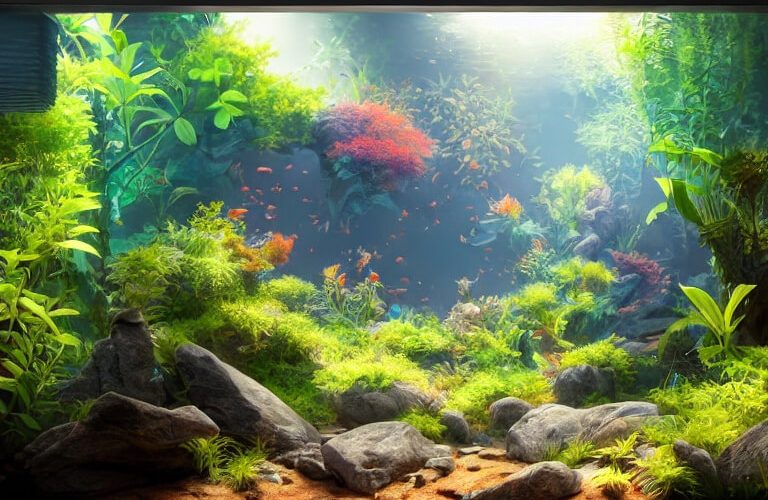Fish tanks require regular maintenance and cleaning to ensure the health and longevity of the fish living inside them. One of the most important aspects of keeping a healthy aquarium is changing the water on a regular basis. Knowing how often to change fish tank water can be confusing for first-time aquarists, as there are many factors that need to be considered. This article will explain why water changes are necessary and how often they should be done.

How Often Should Tank Water Change?
Most experts recommend changing 10 to 25 percent of the water in a fish tank every two weeks. This helps maintain a healthy balance of minerals, pH levels, and other components in the water that are essential for good aquarium health. When performing the water change, use dechlorinated or conditioned tap water to ensure any chlorine or heavy metals present in regular tap water don’t harm your fish.
During this process, it is also important to vacuum out any dirt and debris as well as remove excess algae from the gravel at the bottom of your tank with an aquarium vacuum cleaner. Uneaten food should also be removed during each water change since it can quickly foul up a tank’s environment and increase ammonia concentration if not taken care of promptly.
Additionally, it is recommended that you replace materials such as carbon and filter media at least once a month to ensure your filtration system performs optimally. Lastly, make sure you check the temperature regularly to make sure your tank stays within proper parameters for both cold-water and tropical fish species.
Types of Tanks: Freshwater/Saltwater
Freshwater tanks need to have their water changed more frequently than saltwater tanks. This is due to the fact that freshwater fish produce more waste and are typically kept in smaller tanks, leading to a build-up of waste and toxins over time. An aquarium vacuum can be used to help remove debris from the bottom and sides of the tank which will also reduce toxic levels in the water.
Saltwater tanks tend to require less frequent maintenance as they can handle higher levels of pollutants before it affects their inhabitants. As long as you do regular testing for pH and chemical levels, you only need to do a few small partial changes each month or so. You should still use an aquarium vacuum regularly though as saltwater is prone to algae growth which can harm your fish if not controlled properly.
Additionally, some fish may require larger water changes every couple of months depending on what type they are and how large your tank is.
Reasons to Change Water Regularly
One of the main reasons to change the water regularly is to maintain a healthy environment for fish. The nitrogen cycle is essential for keeping good bacteria in check, as well as preventing harmful ammonia and nitrite levels from building up. When performing regular water changes, these toxins are removed from the tank and replaced with clean water which helps keep your fish healthy.
Another important reason to change the water regularly is to reduce algae growth. Algae can quickly take over an aquarium if not properly managed, and changing out the water can help limit their growth. It also removes any excess food or waste particles that may be in the tank that could lead to an algae bloom.
Finally, frequent water changes will prevent large pH shifts in the aquarium which can be dangerous to your fish’s health. Maintaining a consistent level of alkalinity will help keep your fish stress-free and give them a more comfortable living environment overall.
Factors to Consider: Size, Stocking
When considering how often to change the water in a fish tank, size, and stocking are two important factors that should be taken into account. The larger the tank, the less often you will need to do a full water change. Larger tanks have more room for beneficial bacteria to grow which helps break down waste and keep water quality high without as much maintenance. Stocking is also an important factor when deciding how often to change your fish tank water.
A lightly stocked tank with fewer fish requires less frequent changes than one that is heavily stocked with multiple fish. This is due to an increased amount of waste being produced by more active or numerous inhabitants causing water quality to drop faster than what can be maintained through regular partial changes.
Symptoms of Dirty Water
The most obvious symptom of dirty water in a fish tank is an unpleasant smell. Ammonia and nitrate levels in the water can become too high, which is toxic to aquatic life and produces an odor that is hard to miss. Additionally, cloudy or discolored water may be a sign of unhealthy bacteria levels or chemical imbalances. If left untreated, the fish may develop illnesses such as fin rot or skin lesions due to poor water quality.
In extreme cases, fish may even die from contaminated water. Regular maintenance of the tank and its filter is essential for keeping the aquarium healthy and safe for your pet fish. For most tanks, it’s best to do partial water changes every two weeks to keep ammonia levels low and provide fresh oxygenated water for your fish.
Steps to Changing Tank Water
It is recommended to change 10-15% of the water in an established aquarium every two weeks. This helps keep the water chemistry balanced and removes any buildup of toxins or waste in the tank. To do this, it is important to take a few steps.
First, gather all necessary supplies such as a siphon hose, buckets or jugs for new water, and an aquarium-safe de-chlorinator. Check that the temperature of the new water matches that of the tank before adding anything to it; temperature shocks can be dangerous for fish.
Once everything is ready, use the siphon hose to remove 10-15% of the old tank water from the aquarium and place it in a bucket or sink. Refill with an equal amount of fresh dechlorinated water from your bucket or jug into the aquarium. Repeat this process until the desired percentage has been met, then add any additional necessary treatments such as conditioners for pH balance, etc.
Finally, turn on filtration and aeration equipment like pumps and filters if you have them running in your tank; this will help restore oxygen levels quickly after a partial changeover. With regular maintenance and care, you can keep your fish healthy and safe in their environment!
Benefits of Regularly Changing Water
Regular water changes are an essential part of keeping a healthy aquarium. By regularly changing the tank water, you can remove waste and toxins, replenish trace elements, and improve oxygen levels. This helps to maintain a safe environment for your fish and other aquatic creatures.
Water changes also help to restore balance in the aquarium’s ecosystem. The new water that is added helps to dilute nitrates and phosphates which can cause algae growth if left unchecked. Additionally, regular water changes will replace minerals such as calcium, magnesium, and potassium that are used up by tank inhabitants.
Overall, regular water changes provide numerous benefits for both fish and their keepers alike. By ensuring the safety of their aquatic environment with periodic maintenance tasks like replacing old tank water with fresh new water, hobbyists can enjoy a thriving aquascape with happy fish swimming in it!
Tips for Correctly Changing Water
The frequency of water changes in a home fish tank greatly depends on the size of the tank, the number and type of fish, and how much waste is produced by the inhabitants. It’s important to use dechlorinated water when changing the aquarium water. Chlorine can harm sensitive fish, so always use a de-chlorinator or let tap water sit out overnight before adding it to your tank.
When carrying out a partial water change, siphon any debris from gravel while at the same time removing some old aquarium water from the tank with a bucket or hose. Test for ammonia levels after performing a partial change – if they are still too high then perform another small partial change until levels are back to normal. Finally, remember not to overdo it – small regular changes are better than large infrequent ones as rapid temperature fluctuations can be stressful for fish.
Conclusion: Frequent Changes Essential
It is essential to change the water in a fish tank on a regular basis. This should be done at least once a month, or more frequently if necessary. The frequency of the change depends on the size of the tank, the number, and type of fish, and how often you feed them. The more frequent changes will help keep the water clean, clear, and free from toxins that can harm your fish’s health.
Furthermore, an appropriate amount of fresh water should also be added each time to replace what has been lost through evaporation and other processes such as cleaning filters or gravel vacuuming. Doing this consistently will ensure that the environment remains healthy for all occupants.
Another important factor to consider is adding new water conditioners when needed so that any harmful chemicals can be removed from tap water before it enters the tank. Many products are available on the market which can make this task easier than ever before.
Finally, it is important to remember that even with frequent changes, problems may arise due to disease or poor water conditions which require further action such as treatments or large-scale maintenance work in order to restore balance in your aquarium ecosystem. Therefore it is wise not only to do frequent changes but also to monitor closely for any signs of distress among your finned friends!




